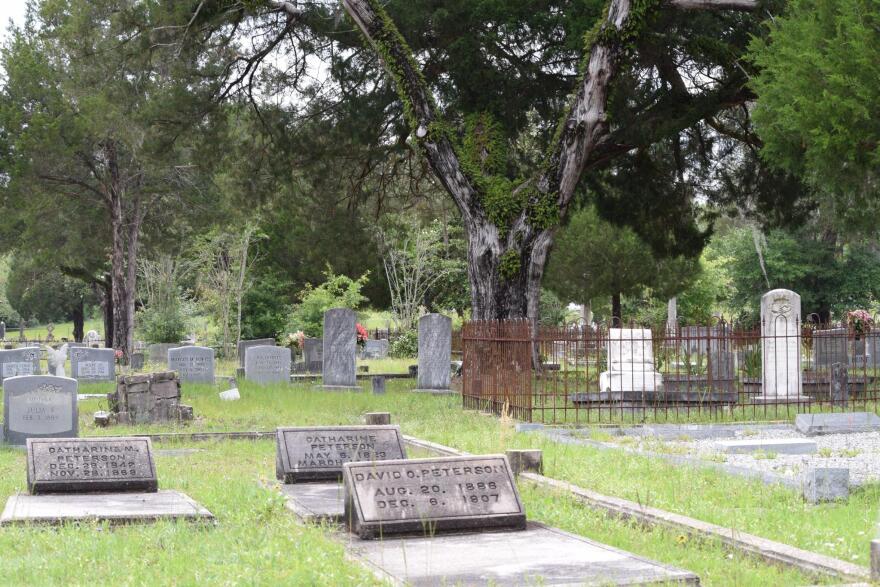Cemeteries tend to get a lot of foot traffic during this time of year with ghost tours and curious wanderers.
But some say cemeteries — and more specifically historic cemeteries — aren’t for spooky antics. They’re historic records.
“They tell the stories of the history and heritage of the area,” said Margo Stringfield, research associate at the University of West Florida. “It’s a place to find out about the people that come before us and what their contributions were.”
It’s not hard to stumble upon a historic cemetery in Northwest Florida. If you pay attention to the headstones, you’ll find some prominent people. Here is a just sampling of what you might find when you visit a historic site … any time of the year.
St. Michael’s Cemetery
St. Michael’s Cemetery is eight acres full of Escambia County’s past. Dating back to the Colonial period, Stringfield said you can tell which headstones are the oldest not just by the dates, but because some of them are hand-carved. The south road entrance on Alcaniz Street was a Colonial-era road dating back to circa 1764.
People from all walks of life are buried at St. Michael’s. Some people of note include Dorothy Walton, wife of George Walton, who was one of the signers of the Declaration of Independence. Dorothy moved to Pensacola in 1821 with her son, George Jr., who was named territorial secretary of West Florida.
“She had a firsthand observation of the formation of our nation and the formation of our state,” said Stringfield. “Even though it’s likely she wasn’t consulted, here is someone who witnessed two formative events.”
Another grave of note is one that belongs to Modeste Hargis, the first female pharmacist in Pensacola.
As the daughter of a doctor, she gained an interest in medicine early and passed the state pharmacy examination in 1893 at the age of 18.
Before local African-American cemeteries were established, there are some early people of color buried at St. Michael's. Ironically, they worked in the funeral industry.
Wade Hampton Harvey was the first black mortician in Pensacola. After his death, the Morris family established the Joe Morris Funeral Home on North DeVilliers Street.

“Ambrose Vaughn also worked exclusively in the African-American community, as well as the Anglo community,” said Stringfield.
It was a big deal for the African-American community to have their own sacred burial spot.
“Enslaved people did not have a choice about where and how they were buried,” explained Stringfield. “It meant very much to them to have a dignified burial ground.”
The earliest headstones at places like AME Zion and Magnolia Cemetery mark final resting spots for people who were born into slavery or were the first generation of non-enslaved people born after
1865, the end of the Civil War.
Both cemeteries are worthy of a stroll to see the elaborate headstones.
“You think about how people memorialized each other,” she said. “They looked after one another. It’s a commitment to your community. The communities are not there anymore, but the cemetery is.”
Milton Cemetery
The Milton Cemetery — originally named Milton Benevolent Cemetery — was established just two years after the city was founded.
According to a historical record compiled by Laurie Green, the land was purchased by James R. Riley in
1844. His father, also named James R. Riley, was already buried at the site.
The second burial was shortly after the city’s incorporation. It was for a 14-year-old girl who had been interred in 1937. For the next two decades, most of the burials were infants and children.
Vernon Compton, spokesman for the Santa Rosa County Historical Society, said many of the early plots in Milton Cemetery were children and infants who died from yellow fever.
“It was a dark period in Milton,” he said.
Family plots started to establish in the 1860s, with more elaborate headstones. There was only a total of 17 burials during this decade. Green reports the decrease was due to the Civil War when most residents left the area.

By 1884, the cemetery had 85 graves scattered throughout the 15-acre plot of land. In 1888, the heirs of
James R. Riley sold the property to the Milton Benevolent Cemetery Association for $100. As for Riley, he has no known marked grave in Santa Rosa County.
Over the years, the cemetery has been maintained through the help of small organizations. In its infancy, Santa Rosa County was the most industrialized county in the state. But when virgin pine forests were depleted, so did the lumber industry.
“It had been predicted by our forefathers that the timber that fueled the development of the town would last for 400 years. It lasted 100 years. They could have never predicted that the cemetery would outlast the trees,” Green wrote.
In more recent years, the cemetery made headlines for incidents of vandalism. In 2017, more than 30 headstones were damaged on Friday the 13 th. The city and Santa Rosa Historical Society have ramped up security since then.
“It’s truly a sacred place,” said Compton. “Loved ones are buried there, so it’s always sad to see that.”


